View photos of RHS Chelsea Flower Show 2022
MEDITE SMARTPLY Building the Future (Gold medal and Best Construction Award (Show Garden))
Creating sustainable landscapes and buildings for the future is a central theme of the exhibit.
The garden, designed by Sarah Eberle, depicts an atmospheric edge of forest garden with a feature building inspired by natural vertical rock strata and constructed using MEDITE SMARTPLY carbon negative products in an innovative way, demonstrating its’ diverse application in all environments.
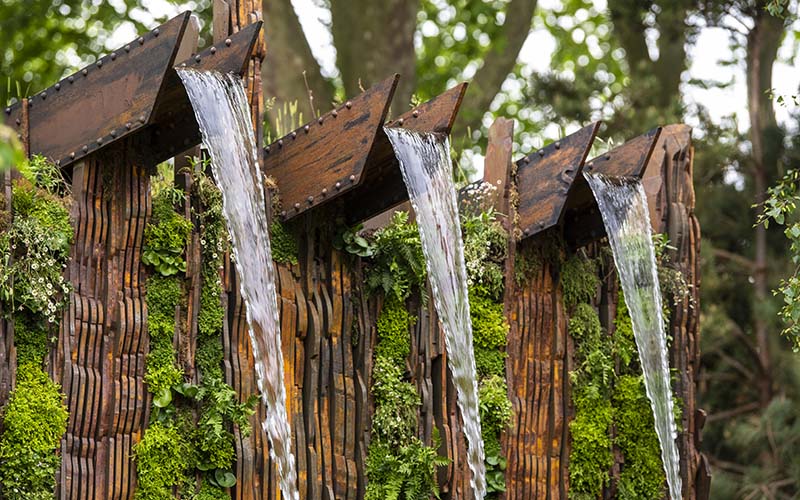
The garden hopes to highlight the wide potential and innovative application of the sustainable products within the range in both a practical and inspirational manner.
The garden building is over 6m high featuring a character tree and green sloping roof. The intended character and atmosphere of the garden is engaging and naturalistic, with the structure and its’ cascading waterfall adding drama to the scene with native naturalised and informal plants coming together to form a stylised landscape.
Planting/Colour Scheme
The primary focus is on texture and forest edge, with a range of unusual plants. Pinus sylvestris is one of the key plants as it is one of the timbers used to produce MEDITE SMARTPLY. Other key plants include Farfugium japonicum, Diphylleia cymosa, Disporum longistylum ‘Green Giant’, and Podophyllum peltatum all as unusual woodland edge plants.
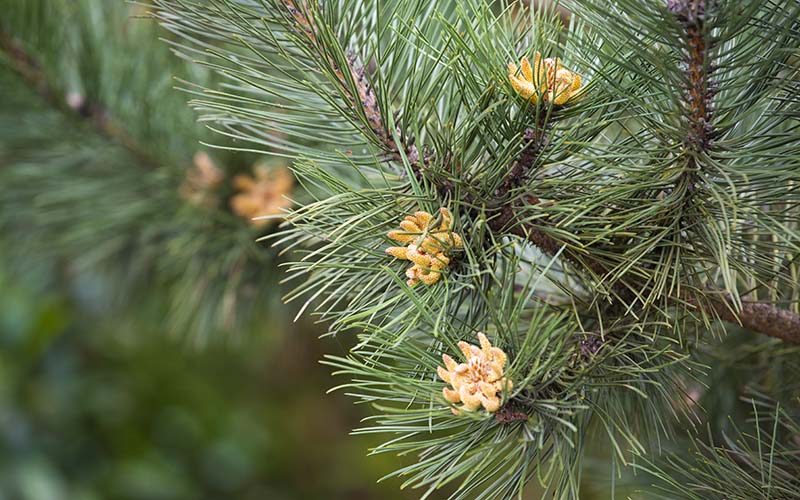
The garden features many native plants that are often overlooked, bringing their valuable aesthetic and environmental contribution alongside rarer specimens. The planting blend is about using historical knowledge, ancient and rare – into the modern environment (which the building will be), respecting heritage through modern application using what we know/have and taking it into the future. Some of these can now be grown around the world reflecting our changing climate.
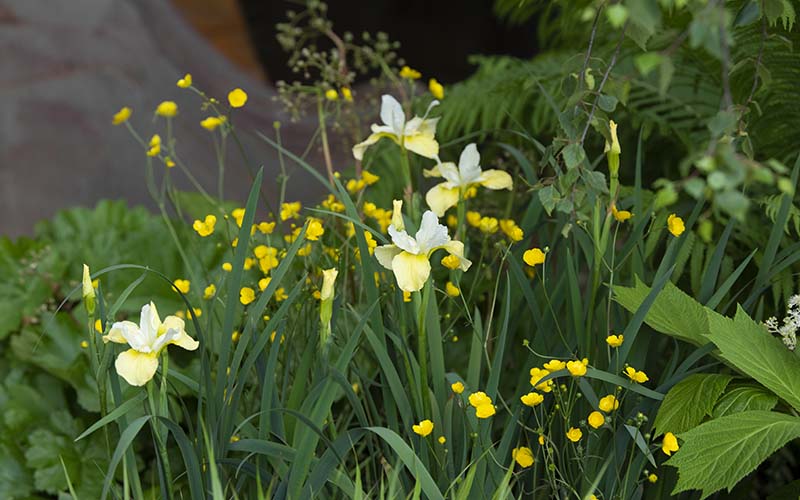
A large part of the garden will be donated to Andover Trees United, a volunteer-led environmental charity.
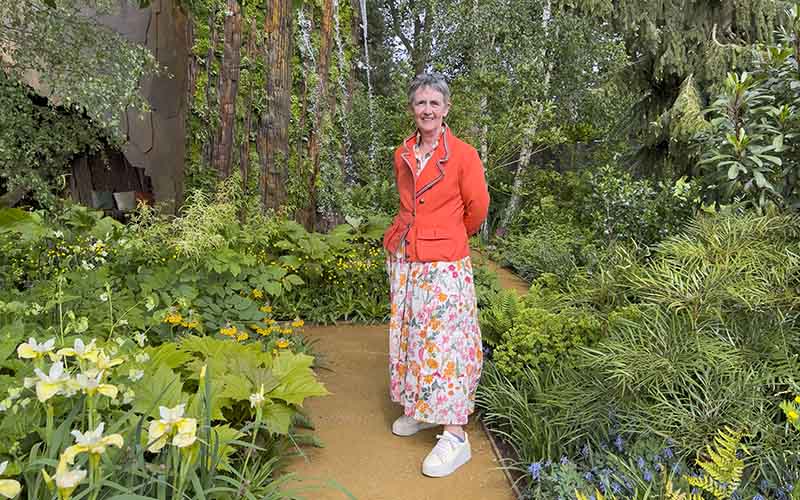
Hampshire nursery Hortus Loci are again supplying show gardens:
Hands Off Mangrove by Grow2Know (Silver-gilt medal)
Designed by Tayshan Hayden-Smith and Danny Clarke, this garden unites two prominent issues – global deforestation and social injustice.
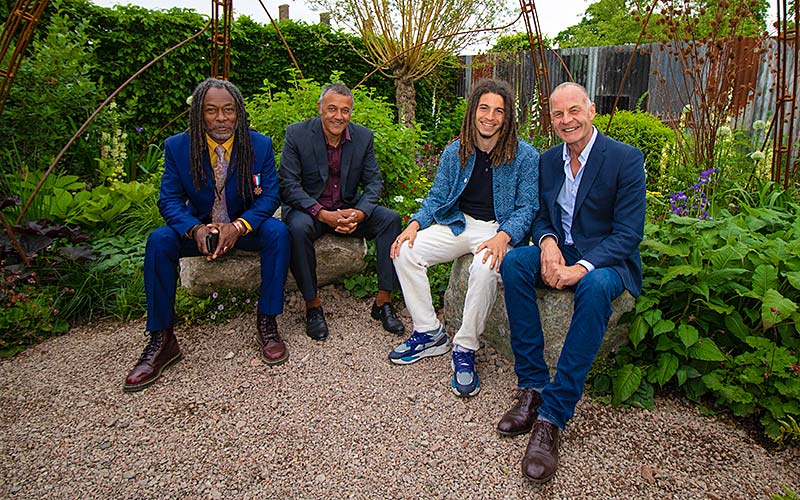
The mangrove tree is a symbol of diversity, coexistence and resilience. Hands Off Mangrove by Grow2Know is reflective of the community of Notting Hill where the ‘Mangrove Nine’ stood up in the face of adversity and inspired positive change for future generations, and as an ‘ecosystem engineer’, home to thriving, biodiverse ecosystems crucial to our understanding of the climate change crisis.
The mangrove sculpture stands proud in the garden at 4m high, with nine main roots honouring each ‘Mangrove Nine’ member. The corten steel rebar roots create a protective canopy, under which communities can gather, sit and reconnect with each other and nature.
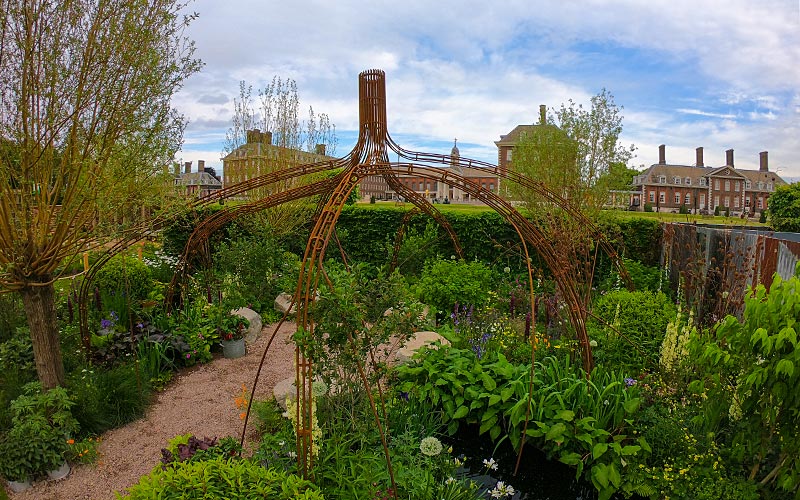
Immersed in a garden abundant with pollinators, edibles and ornamental plants, the crushed concrete path represents the harsh challenges and threats of racism, poverty and violence of life in 1960/70s Notting Hill, many of which endure in our communities today.
While mangroves are beautiful trees, the deliberately deforested sculpture is a stark reminder of the impacts we are having on our planet’s most important ecosystems.
Planting/Colour Scheme
The planting in the garden speaks to the relocation in the community of North Kensington.
Plants have been carefully selected to thrive in the garden’s second life in the community in inner city London. Grow2Know is an advocate for promoting biodiversity and wildlife.
Plants chosen are a combination of edibles and ornamental, which will create a tranquil, functioning space whilst also signalling the importance of food in community gardens and public spaces – especially as the restaurant, the Mangrove, was a place where food brought people together.
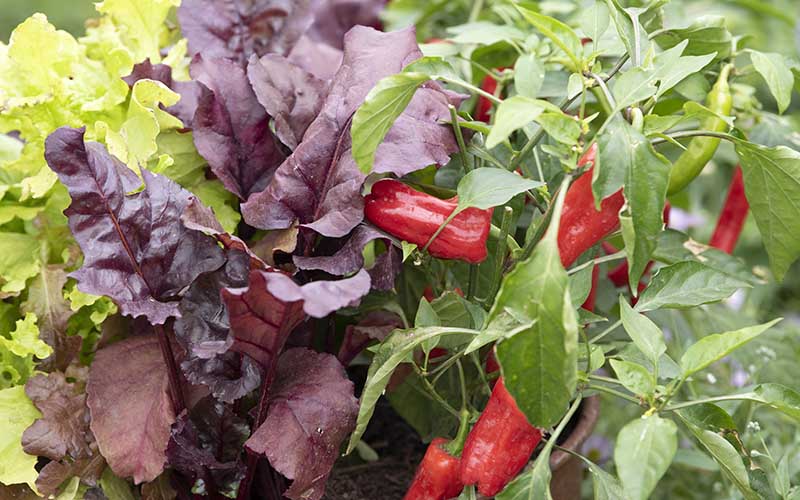
St Mungo’s Putting Down Roots Garden by Cityscapes (Silver medal)
The garden, designed by Cityscapes – Darryl Moore & Adolfo Harrison, embodies St Mungo’s Putting Down Roots’ work in public urban gardens and Cityscapes’ creative approach to shaping spaces and reusing materials, as it celebrates the 10 year anniversary of working collaboratively to transform lives, communities and places.
The garden is an urban pocket park, an inclusive place bringing people and plants together in the city, highlighting the ways green spaces provide personal and social, health and wellbeing benefits. The planting focuses on green textural foliage punctuated with floral accents of colour, bestowing the garden with a sense of tranquility, contrasting with the vibrant colours in the hard landscaping, made from recycled materials. Large planters throughout the garden provide a sense of height and enclosure, creating an immersive and safe experience for users and the pavilion structure with a bench made from three large hoops provides opportunities for dwelling and respite from the pressures of city life.
The garden hopes to highlight the importance of bringing people and plants together in public places, through the creation of green spaces that are innovative, inclusive and sustainable, and their ongoing maintenance as a route to recovery, as exemplified by the work of St Mungo’s Putting Down Roots.
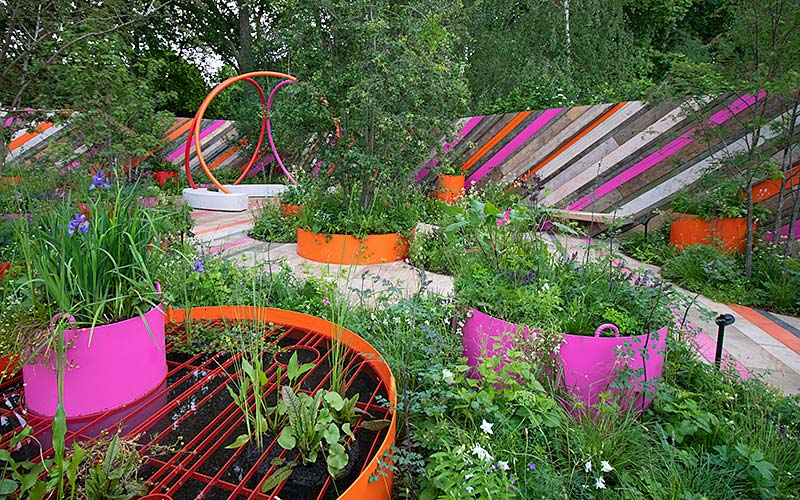
Planting/Colour Scheme
The planting scheme is based on a matrix with approximately half of it consisting of various grasses (Luzula, Deschampsia, Carex, Melica), and the other half of perennials. A large number of native plants are used to show their versatility and beauty.
Key plants will include Galium odoratum, prolifically spread to ensure a ground layer; Geranium nodosum to provide great low coverage and flowering for 8 months; Sesleria caerulea, one of the matrix species unifying the while garden; Fagopyrum dibotrys, a great tall accent plant; and Crataegus monogyna (hawthorn), a native tree with a strong spring floral display, and important habitat and source of food for biodiversity, it is also resilient as a pioneer species in urban areas.
Alder Hey Urban Foraging Station (Silver-gilt medal)
The Alder Hey Urban Foraging Station by Howard Miller and Hugh Miller is a woven landscape; it is about weaving together the young and old, green and urban, play and learning and Alder Hey Children’s Hospital with its community.
At its core is the aspiration to inspire children to lead active, healthy, pleasurable lives.
The garden is infused with the magic of discovery inherent to foraging. Visitors first encounter the
garden as nostalgic glimpses through rampant, blossoming hedgerows. Within, a sense of freedom prevails; explore, ‘leave the path’, get lost in your own world.
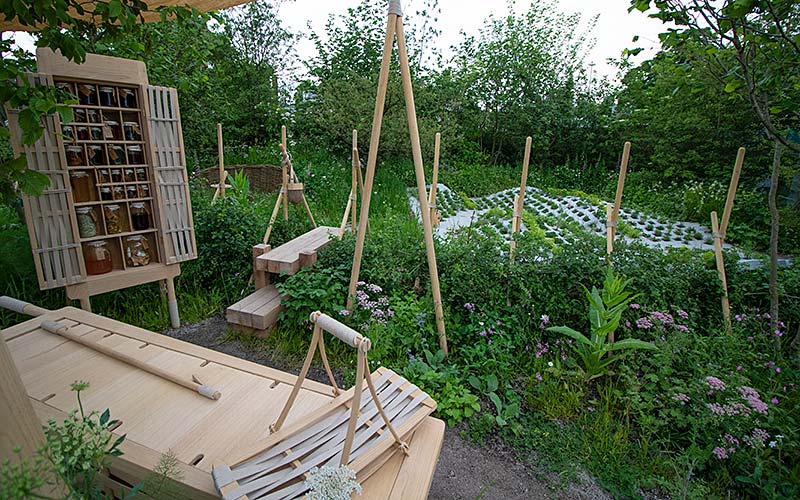
A design language of woven forms associated with foraging is abstracted into a woven landscape. Precast concrete ‘strands’ make up a picnic blanket laid over an undulating landscape with edible herbs growing through. The garden features a moveable foraging kitchen and a picnic blanket feature.
The garden is mindful of children’s mental health and is designed to encourage engagement with nature through foraging, sharing healthy food, play, relaxing together and being in the moment.
The garden will be relocated to the Alder Hey Hospital near to the entrance of the new Children’s Mental Health Unit to become an integral part of the healthcare campus and the green spaces that connect a cluster of state of the art facilities including the hospital, mental health facility, research institute, bereavement centre and the brand new surgical neonatal unit.
Planting/Colour Scheme
The planting scheme is drawn from species naturalised to the UK that flower in late May and have a forageable contribution to the garden. The garden isn’t intended to be a re-creation of pastoral scenes of yesteryear but rather a stylised remembering of orchards, meadows and blossoming hedgerows. It is intended to awaken the excitement of exploring a new rich world packed full of edible wild goodies to discover. The colour scheme is inspired by apple blossom; whites, creams and blush pinks.
Key plants include Malus sylvestris, important for its blossom and autumn fruit, it is also a quintessential foraging species; Crataegus monogyna creating the ‘hedge tunnel’ into the garden; Anthriscus sylvestris and Daucus carota, two meadow umbels that conjure up a frothy, dream-like quality of a forgotten orchard or meadow; Papaver dubium subsp. lecoqii ‘Albiflorum’ commonly referred to as Beth’s poppy, a small, delicate pink flower that will dance across the top of the picnic blanket. The planting of the picnic blanket differs from the rest of the garden with a mixture of culinary herbs including various cultivars of Thymus, giving off fragrance as people move about the blanket or sit on it.
Director and Trustee of Exbury Gardens Marie-Louise Agius was chair of the show garden judges.

Southampton-based Pip Bensley created the amazing floral work for the press call flowers on the Brewin Dolphin Garden. She designed flower adornments with garden roses including Juliet, Kate and Free Spirit on a base of soft aluminium wire so it moved as the mother and daughter danced.

The Place2Be Securing Tomorrow Garden (Gold medal) is a first-time Chelsea Show Garden by Hook-based designer Jamie Butterworth.
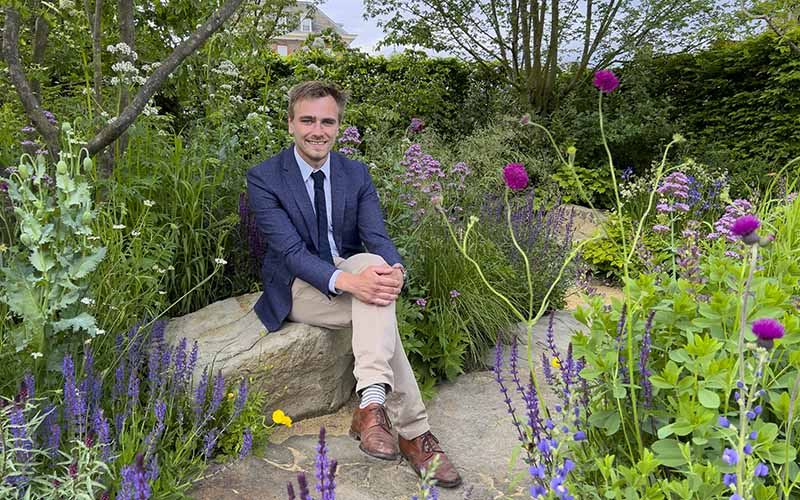
The garden is designed to be a sanctuary for children who need a place to feel safe and calm, and where they can meet with someone to talk about what’s on their mind, be it a Place2Be mental health practitioner, therapist, teacher, family member or friend. It is a space that facilitates and stimulates conversation.
The outdoors and a connection with nature have never been more important than they have over the past two years. This garden has been designed for Viking Primary school in Northolt, West London, where it will be relocated after the show to become a useable space for children whose own homes have little, or no, outside space.
Jamie spent time with the school children to learn about the sort of garden they would want, as well as with the teachers and practitioners on what sort of space helps facilitate positive conversations.
The garden links closely the designer’s own family, with his mother being a primary school teacher and father a mental health nurse.
The planting takes centre stage in the garden, with trees providing structure and the herbaceous planting providing texture and subtle colour. Stone is the consistent hard material throughout the garden: boulders provide shape and places for children to sit and talk, while crushed stone is used on the surface. Organic-shaped, sculpted oak seats will form a focus for conversation in the garden space.
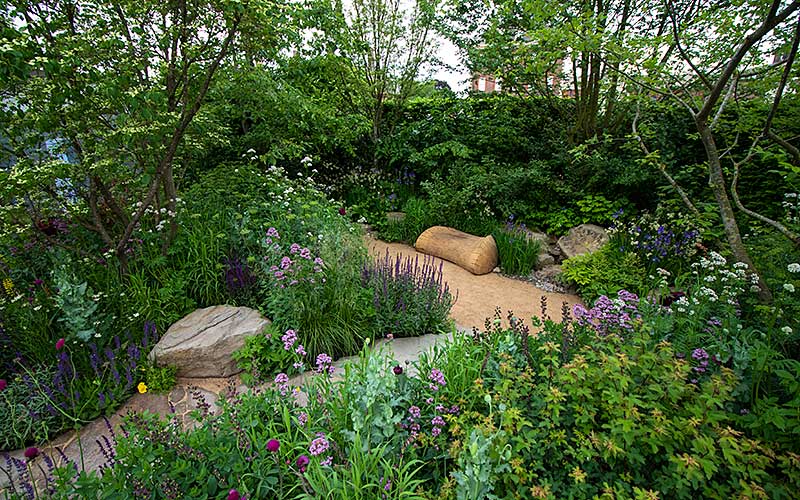
Place2Be’s mission is to improve the mental health of children and young people. They believe that no child or young person should have to face mental health problems alone.
Sarasin & Partners has been supporting the work of Place2Be for the past two years and this garden shines a spotlight on the vital importance of prioritising mental health support from an early age, to reap the benefits not just for the individual and their life chances, but for society as a whole.
Planting/Colour Scheme
The planting is lush, green and provide a feeling of enclosure. Pops of blue, yellow and burgundy, colours suggested by the children at Viking Primary school, are used to add a splash of cheerful energy to the garden.
The Body Shop Garden
Hardy’s Cottage Garden Plants have retired from showing at RHS Chelsea but they still supply plants from their Hampshire nursery. This year they grew for The Body shop Garden.
This conceptual garden tells a story of environmental and societal regeneration, a journey from a state of burnout to wellbeing. The space and shape of the garden-as-sculpture are defined by a series of Corten steel arches in various states of char, dividing three segments of planting that tell the regeneration story from charcoaled, diminished forest floor to a verdant, diverse explosion of plant life. The rhythm of the arches, a key feature, defines the passing of time for the viewer.
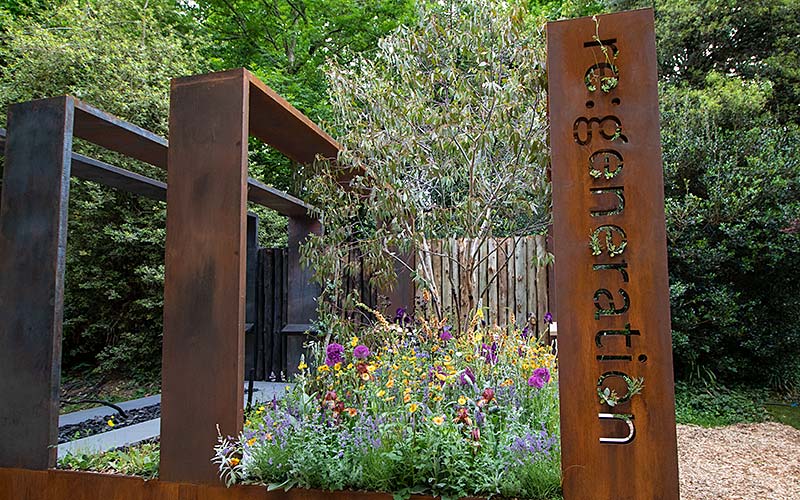
The garden is inspired by the new generation of changemakers and activists, and the stress and anxiety of social challenges they face whilst continuing to fight global issues from climate change to race. The garden has a positive message – if we take the time to nurture ourselves and our environment, life can thrive.
Planting/Colour Scheme
Planting has been selected to represent the stages of environmental and societal regeneration as told through the garden. Eucalyptus represent the fire-adapted forests being lost to repeated catastrophic forest fires whilst fire poppies typify the ephemerals whose growth is stimulated by heat and represent the first stage of regeneration. Iris are a symbol of wisdom, hope, faith, and valour, all qualities an activist needs.
The Discovery Zone can be found inside the Great Pavilion and it’s the place to go to see the educational exhibits. Sparsholt College are again showing the talents of their horticultural students.
Sparsholt College: Home from Home, sponsored by Maggie’s Southampton (Silver-gilt medal)
Maggie’s is a registered charity that provides free emotional, practical and social support for people with cancer and their families and friends. Maggie’s relies on voluntary donations from the local community so that their cancer support specialist, Psychologist and other specialist staff can provide this support all year round for free. Currently 24 centres are open with six in the planning stage. Each centre is a warm and welcoming place, with professional staff on hand to offer the support people need to find their way through cancer. Each one reflects their local area, and is attached to a NHS Hospital, considering the cancer need within each geographical area.
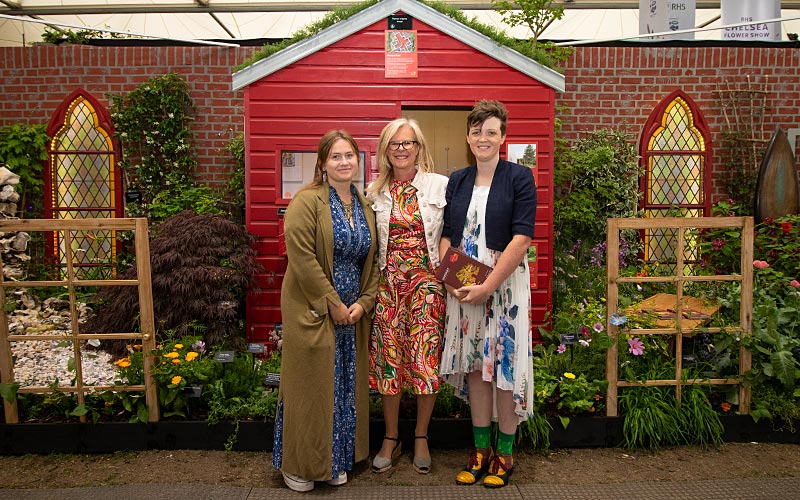
‘Home from Home’ takes inspiration from the Maggie’s Southampton architecture and landscape brief, together with founder Maggie’s own interest in Chinese gardens and her personal experience of cancer affecting the whole network of those involved. Around the edge of the garden are a series of open windows giving a different view of the garden and this represents the different starting points of people after diagnosis. The hard landscape represents the differing personal journey that each person takes and includes organic curves, reflecting the interest Maggie had in Chinese gardens and her husband, Charles Jencks’s, architectural and landscape style. The planting engages all the senses and avoids sharp spines and thorns as any wounds could assist with infection.
The planting encourages calmness and contemplation with different viewpoints and areas of interest.
Places to sit and chat or read are included with steppingstones used for a paced and careful approach.
Sparsholt also entered Plant of the Year and were shortlisted to the final 20 with two entries – Forsythia × intermedia ‘Discovery’ (syn. JOHN MITCHELL) and Geranium pratense ‘Storm Cloud.’ The winner was × Semponium ‘Destiny’ from Surreal Succulents in Cornwall.
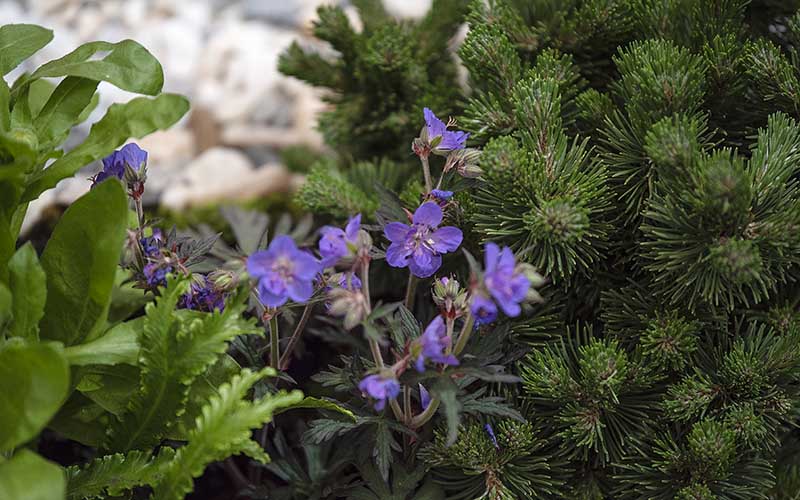
Ringwood-based New Forest Hostas & Hemerocallis are showing a stunning display of hostas in the Great Pavilion. Catch them on stand GPD159.
Hortus Loci also supplyied all the balcony gardens (pocket-sized realistic garden in the footprint of generous 2m x 5m balcony) so look out for The Blue Garden, JAY DAY, The Potting Balcony Garden Sponsored by Viking, Cloud Gardener UK: The Cirrus Garden, The Enchanted Rain Garden, Wild Kitchen Garden, A Mediterranean Reflection and The Still Garden. And they also did the BBC balcony.
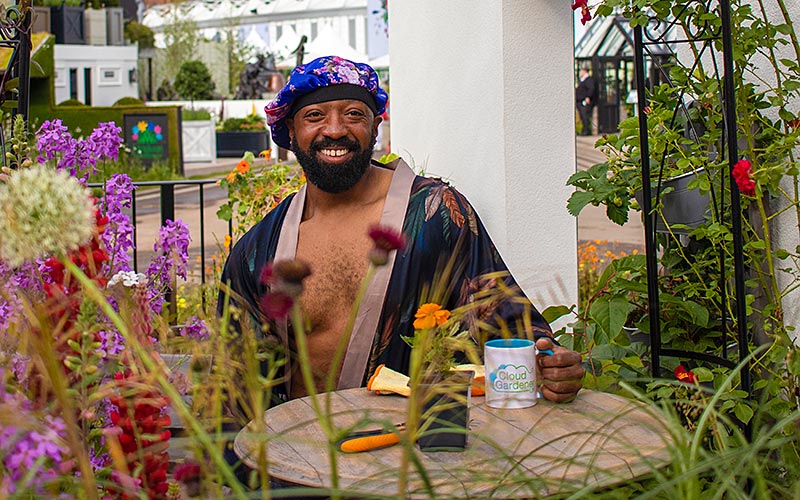
Nestled in a peaceful corner of the show, is Jardin Blanc with menus designed by Raymond Blanc OBE. Two of Hampshire artist Stephen Myburgh’s hand crafted copper seats can be found inside.
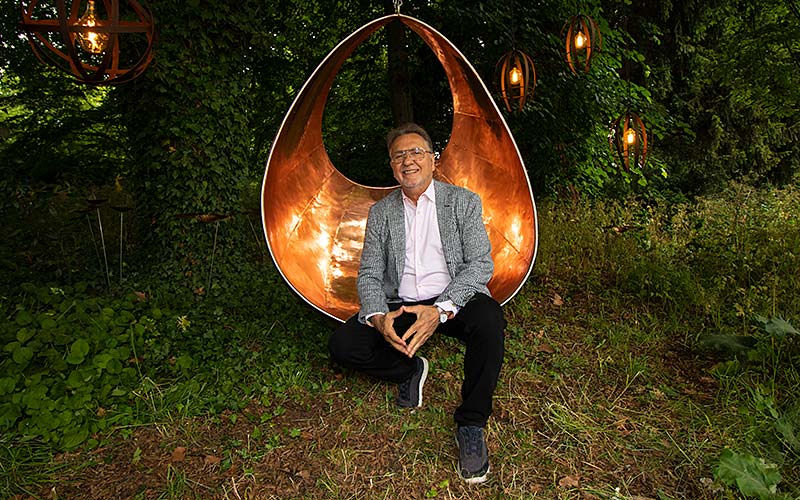
Look out for the work of Hampshire designer Ann-Marie Powell who designed the planting on the Gaze Burvill stand. It’s one of the largest trades stands and is on main avenue and it was awarded five stars.
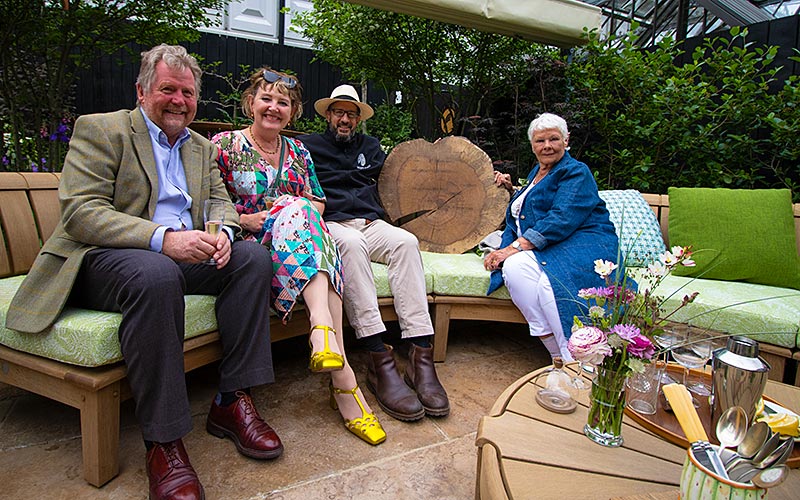
Trade stands showcasing Hampshire businesses:
Alitex Ltd, Petersfield
Site No: MA334
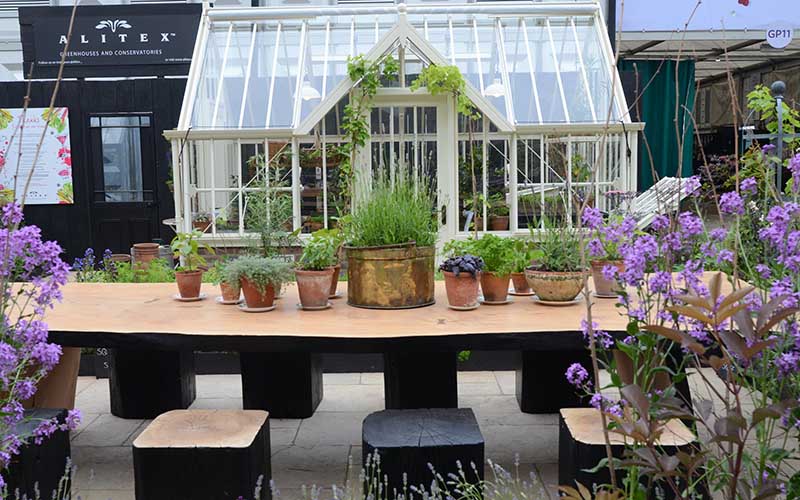
Andy Small Photography, Cliddesden
Site No: EA509
Flower and nature photography
Creative DeZigns, Eversley
Site No: AR522
Ethical cotton clothing and artisan accessories
Gaze Burvill Ltd, Alton
Site No: MA333
Oak outdoor kitchens and furniture
GBBC Ltd, Winchester
Site No: EA458
Hand care and fragrance products
Griffin Glasshouses Ltd, Ropley
Site No: RHW611
Victorian style glasshouses
Myburgh Designs, Liphook
Site No: RHW613
Garden sculpture and furniture
Natasha Hulse, Fordingbridge
Site No: EA454A
Bespoke fabric artist
The Delphinium Society, Romsey
Site No: EA501
Delphiniums in garden setting